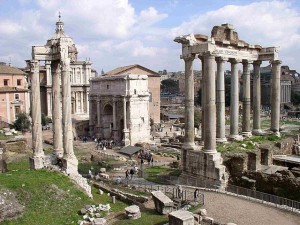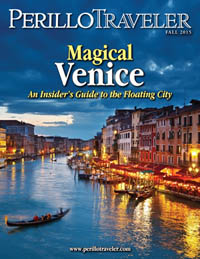 Proving there’s always something new to discover among Rome’s ancient treasures, the Roman Forum recently opened a newly restored section to the public for the first time. The Imperial Ramp, a more than 2,000-year-old pathway connecting the public part of the Forum to emperors’ private residences, offers a new look at how the rich and famous lived in ancient Rome.
Proving there’s always something new to discover among Rome’s ancient treasures, the Roman Forum recently opened a newly restored section to the public for the first time. The Imperial Ramp, a more than 2,000-year-old pathway connecting the public part of the Forum to emperors’ private residences, offers a new look at how the rich and famous lived in ancient Rome.
Emperors such as Domitian, who ruled Rome from 81 to 96 A.D. and commissioned the ramp, likely traversed the steep walkway on horseback, enabling them to quickly escape the Forum if necessary and also to supervise the city from atop Palatine Hill. Though the emperors’ residences were relatively close to the public – Palatine Hill is only 180 feet high – the tunneled ramp provided a sense of seclusion and exclusivity.
“We don’t know whether carts would have travelled up and down it with supplies, but certainly horses would have been able to,” said archaeologist Patrizia Fortini.
The arched, covered ramp was built in the 1st century A.D. and features remnants of vibrantly colored frescoes from the 8th century, tidy brickwork, and 36-foot ceilings. The ramp leads from the ground level of the Roman Forum – where tourists wander, much like ancient Romans may have as they conducted business – and zigzags up to Palatine Hill – home of the Imperial Palace, a residential complex where many emperors built luxurious homes – and its panoramic views of Rome. According to Archaeological Superintendent of Rome Francesco Prosperetti, the ramp is divided into sections with different routes used for servants and patricians.
“For centuries, this was the entrance to the imperial palaces on top of the Palatine Hill,” said Francesco Prosperetti, the archaeological superintendent of Rome. “When it was discovered, this was a little-known corner of the Forum.”
Though the ramp was discovered in 1900, restoration began in 2009. While excavating the site, archaeologists discovered ancient artifacts such as a stone and marble latrine, several marble statues including ones depicting the god Hercules, and remnants of stone and marble work. Some of these finds are being housed in rooms off of the cavernous pathway, which were possibly used by guards. The frescoes depict the 40 Martyrs, a group of Roman soldiers who converted to Christianity and were ordered to their death by standing in a freezing lake.
The ramp originally had seven levels, including some underground, and was more than 300 yards long; only four levels are still standing, as the rest are believed to have collapsed in an earthquake in the 9th century. A lavish marble arch, which was the original entrance to the ramp, has been reconstructed using partly original marble materials; it led to a foyer that was used as a church in the Middle Ages, indicating that the ramp was used long after Domitian’s assassination in 96 A.D.
Another ancient covered walkway used by both servants and nobility, the Clivus Vittoria, is slated to open to the public this spring, as well as Santa Maria Antiqua, a sixth-century church.
Roman Forum
Via dei Fori Imperiali, Rome
Hours: 8:30 a.m. until one hour before sunset
A 12€, two-day ticket buys admission to the Roman Forum, the Colosseum and Palatine Hill.
By Kathy McCabe
 Want to read more about travel? Get your free copy of our new digital magazine, Perillo Traveler!
Want to read more about travel? Get your free copy of our new digital magazine, Perillo Traveler!
